Energy transformation or energy conversion is the process of changing one form of energy to another.
Energy transformation is changing one type of energy into another.
This can include electric energy into light energy, and heat into motion.
When energy is changed through, say, a light bulb, it creates heat as well as light but the heat is unwanted so it's considered waste.
All energy transformations create some amount of waste.
The energy of food could be transformed into energy to play.
Chemical energy from coal, oil and natural gas can be transformed into heat energy (the process of burning the fuel).
The heat energy can be converted into kinetic energy by gas turbines or into electrical energy by generators.
Another example is the wind turbine that you know. The turbine uses wind energy and transform into electricity.
Solar panels transform light into electricity.
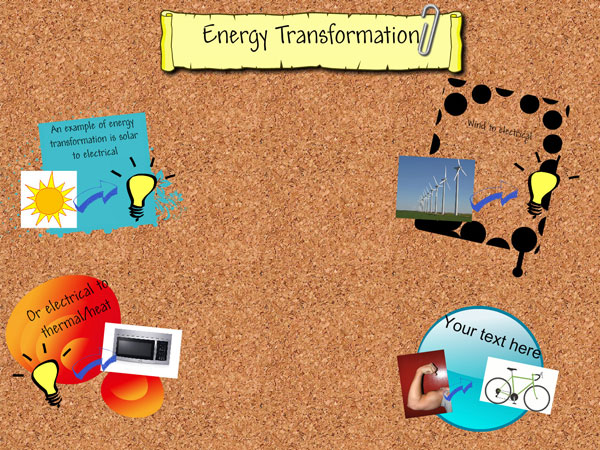
Standard 8
1. What is the form of energy contained in maize, kerosene, and battery before use?
A. Electrical energy B. Light energy
C. Heat energy D. Chemical energy
2. Use the diagram below to answer the question that follows.

Which one of the following shows the correct order of energy changes that take place from the time of lighting the wood until the turbine turns?
A. Heat – kinetic – chemical
B. Chemical – heat – kinetic
C. Chemical – kinetic – heat
D. Heat – chemical – kinetic
3. Which one of the following processes is WRONGLY matched with its energy transformation?
|
Process |
Energy transformation |
| A. A pendulum swinging from left to right |
Kinetic – potential – kinetic |
| B. Burning wood to boil water |
Chemical – heat - kinetic |
| C. Turning a dynamo by hand |
Chemical – kinetic – electrical |
| D. Water flowing downhill turning a water wheel |
Potential – kinetic – kinetic |
4. Below is a diagram of an electric bell. Study it and answer the questions that follow.
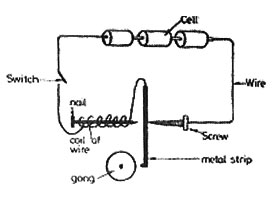
Which one of the following statements is FALSE about the working if the electric bell?
A. The nail becomes magnified when the switch is turned on.
B. The screw must be touching the metal strip before the switch is closed.
C. The nail loses its magnetism when the metal strip strikes the gong.
D. The switch must be opened to release the metal strip from the magnetized nail.
5. The diagram below shows how a lemon can be used to light a small bulb.
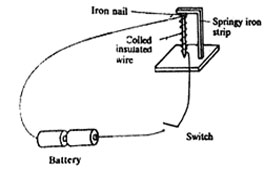
Which one of the following correctly shows the energy changes which take place until the bulb lights?
A. Electrical – chemical – heat – light
B. Chemical – electrical – heat – light
C. Chemical – heat – electrical – light
D. Electrical – heat – chemical – light
6. The figure below represents a simple circuit that can be used to send a sound signal to a station.
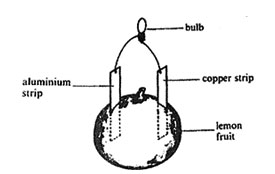
Which one of the following shows the correct order of energy transformations that occur from the time the switch is put on to the time the sound is produced?
A. Chemical – electrical – kinetic – magnetic – sound
B. Electrical – chemical – magnetic – kinetic – sound
C. Chemical – electrical – magnetic – kinetic – sound
D. Electrical – kinetic – chemical – magnetic – sound
7. A kerosene stove was used to boil water to produce steam for turning a model turbine. Which one of the following shows the correct order of energy changes that took place?
A. Heat – chemical – mechanical
B. Chemical – heat – mechanical
C. Chemical – mechanical – heat
D. Heat – mechanical – chemical
8. A charcoal burner was used to boil water and the steam produced was used to turn a turbine.
Which one of the following shows the correct order of the energy changes that took place from the time the charcoal was lit to the time the turbine turned?
A. Chemical – heat – mechanical
B. Heat – chemical – mechanical
C. Chemical – mechanical – heat
D. Heat – mechanical – chemical
9. Which one of the following energy transformations takes place when a dynamo is rotated to light a bicycle lamp?
A. Mechanical – heat – electrical – light
B. Chemical – mechanical – heat – light
C. Chemical – electrical – heat – light
D. Mechanical – electrical – heat – light
10. The sketch below shows the production and transmission of electricity to a house.
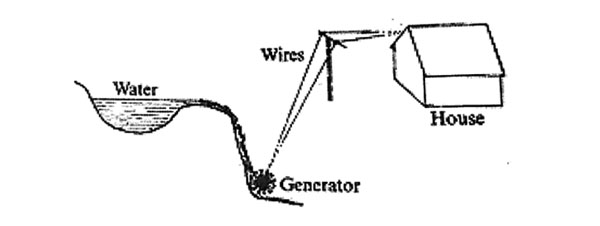
If the electricity is used for cooking, which one of the following indicates the correct energy transformations involved?
A. Potential – electrical – mechanical – heat.
B. Mechanical – heat – potential – electrical.
C. Potential – mechanical – electrical – heat.
D. Mechanical – potential – heat – electrical.
11. Some pupils made a simple circuit arrangement as shown in the diagram below.
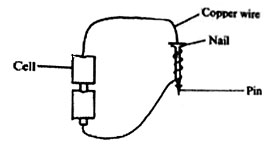
Which one of the following id the correct order of energy transformations that occurred when the arrangement was used to pick a pin?
A. Chemical – electrical – electromagnetic – mechanical
B. Electrical – chemical – electromagnetic – mechanical
C. Chemical – electromagnetic – electrical – mechanical
D. Electromagnetic – electrical – chemical – mechanical
12. The diagram below represents a set-up that was used to warm water in a sufuria placed on top of a cooking pot.
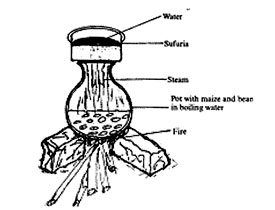
The energy changes involved were
A. Chemical – heat – kinetic – heat
B. Heat – chemical – heat – kinetic
C. Chemical – kinetic – heat – kinetic
D. Heat – kinetic – chemical – heat
13. The set-up below can be used to make a temporary magnet.
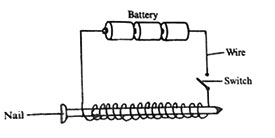
The magnetic power of the nail can be increased by
A. Connecting the cells in parallel.
B. Reducing the number of coils.
C. Switching it on for a longer time.
D. Increasing the number of coils.